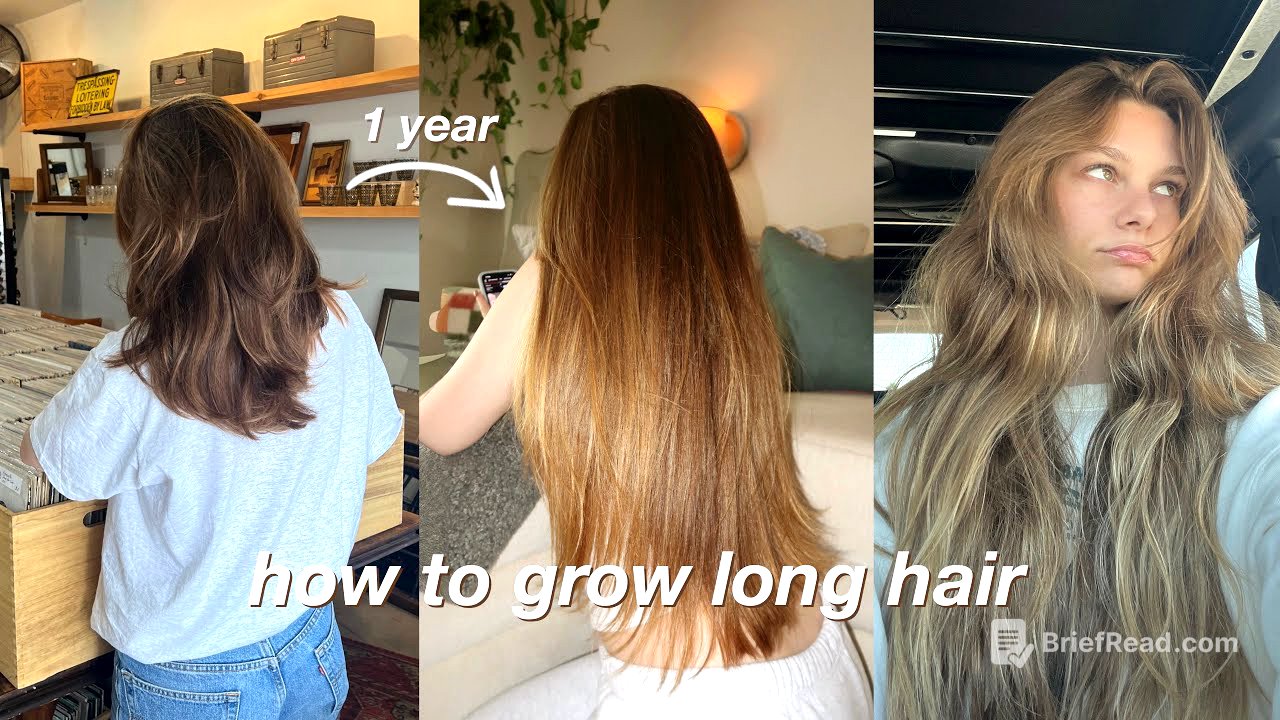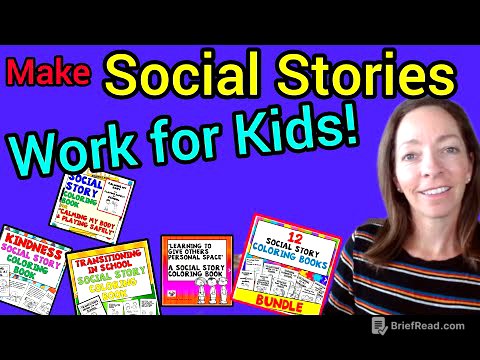TLDR;
This video is about how to grow long, healthy, and thick hair. Kayli shares her personal experience and provides tips on diet, scalp health, length protection, and lifestyle habits that promote hair growth. She emphasises that genetics play a role, but proper hair care can significantly improve hair health and thickness.
- Diet and nutrition are crucial for hair health.
- Scalp health, including proper cleansing and exfoliation, is essential for hair growth.
- Length protection, such as regular trims and gentle handling, prevents breakage and promotes thicker ends.
- Lifestyle habits, like getting enough sleep and managing stress, can impact hair growth.
Intro [0:00]
Kayli introduces the video as her most requested ever, detailing her year-long journey to grow her hair longer, healthier, and thicker. She highlights the issues she faced, including damaged hair that seemed to be stuck at one length. She shares that her hair was at 16-17 inches at the start of her journey and has now reached 25 inches, with 6-7 inches cut off during the year. She aims to share everything she has learned to help others achieve similar results, despite not being a professional.
Disclaimers [1:58]
Kayli clarifies that she is not a professional but is passionate about hair care and its science. She acknowledges the difficulty in finding factual, science-backed information and admits she could be wrong, urging viewers to do their own research. She notes that her tips may not be suitable for those with medical or scalp conditions and advises consulting a dermatologist or trichologist. She also addresses the common belief that hair growth is solely genetic, admitting she has good hair genetically but has improved its strength and thickness through proper care. She stresses that nothing can grow hair faster than its natural rate, dispelling common myths.
Diet [6:10]
Kayli discusses the impact of diet on hair health, emphasising the saying "you are what you eat". She reveals that she took no supplements, instead focusing on incorporating healthy fats and vitamin-rich foods into her diet, such as salmon, avocado, nuts, berries, sweet potatoes, eggs, and spinach. She highlights the importance of protein and suggests including foods that block DHT, a hormone that can cause hair loss, like pumpkin seeds. She advises balancing the intake of dairy and sugary or greasy foods, as their indirect effects can hinder hair growth.
Supplements and Vitamins [8:11]
Kayli shares her observations on supplement use, noting its normalisation in America. She points out that modern foods may lack the nutrients they once had, potentially leading to deficiencies. She advises against blindly taking supplements without knowing specific deficiencies, as incorrect dosages can be ineffective or harmful. She mentions omega-3 for reducing scalp inflammation, vitamin D for preventing hair loss due to deficiency, and other vitamins like zinc, selenium, copper, folic acid, biotin, and vitamin C for strengthening hair and supporting cell renewal. She prefers incorporating these vitamins through food rather than supplements.
Hair Growth Stunters [10:38]
Kayli addresses factors that stunt hair growth and cause hair loss, starting with the myth of hair training. She shares her personal experience of how infrequent washing clogged her hair follicles, hindering growth. She stresses that washing frequency varies for everyone and should be based on individual needs, such as oiliness and hormone levels. She also identifies poor diet and insufficient sleep as significant hair growth inhibitors. Lack of sleep can weaken hair follicles, push premature follicles into the shedding phase, mess with hormone levels, raise cortisol levels, and reduce blood circulation, depriving hair follicles of oxygen and nutrients.
Lifestyle Habits [15:20]
Kayli shares lifestyle habits she has adopted to promote hair growth, including getting 8-10 hours of sleep, especially during her period. She also discusses the benefits and potential drawbacks of exercise, noting that while it can improve blood circulation, high-intensity workouts can raise stress hormones like cortisol, potentially slowing hair growth.
Scalp Health [16:32]
Kayli emphasises the importance of scalp health, recommending avoiding hair training and washing hair when it gets oily. She shares her hair cleansing routine, including double cleansing with specific shampoos and using a clarifying shampoo one to two times a month to remove buildup. She also recommends exfoliating the scalp using a scalp massager or a salicylic acid scalp treatment to prevent clogged follicles and dead skin buildup.
Scalp Massages [19:05]
Kayli discusses the benefits of scalp massages, which promote circulation and strengthen hair strands. She suggests massaging the scalp for up to 10 minutes using fingers, a scalp massager, or a bamboo brush, ideally in the mornings and before bed.
Hair Oiling [20:16]
Kayli shares her three-year experience with hair oiling, highlighting its transformative effects on her hair's texture and strength. She dispels the misconception that it makes hair grow faster, clarifying that it helps grow healthier, stronger strands and improves hair density. She details her hair oiling routine, starting with a five-minute scalp massage using a bamboo brush, followed by applying rosemary oil (diluted with carrier oils) to the scalp. She stresses the importance of using the right oil for your hair type and avoiding excessive amounts. She also shares that she uses argan oil for her mids and ends. She advises against being rough with hair, brushing, or using tight hairstyles when having an oil mask in. She recommends leaving an oil mask in for 3-4 hours and always double shampooing afterwards. She does an oil mask one to three times a week and never applies a hair oil mask when dry shampoo is in the hair. She notes that increased hair shedding after oiling is normal and that it takes 3-6 months to see results.
Length Protection [26:35]
Kayli considers length protection more important than oiling, aiming for thick ends. She debunks the myth that cutting ends makes hair grow faster, stating that trims are only necessary for split ends. She explains that split ends cannot be repaired and will continue to split up the hair shaft if not cut off. She recommends trims every 4-6 weeks for those who consistently bleach or use heat. She shares her experience of cutting off 4 inches of hair to remove damage and layers, as layers are prone to split ends.
Terminal Length [29:47]
Kayli discusses terminal length, the maximum length hair can grow, which varies for everyone. She explains the four phases of the hair cycle: the anagen phase (growth), the catagen phase (transition), the telogen phase (resting), and the exogen phase (shedding). She notes that factors that stunt hair growth affect the anagen phase, causing premature hair fall. She emphasises the importance of caring for the lengths of the hair to prevent them from turning to dust at their maximum length.
Leave-in Conditioner and Hair Oil [31:56]
Kayli shares that she avoids hair dust by using leave-in conditioner and oiling her ends. She always applies leave-in conditioner after shampooing and conditioning to keep her ends moisturised and improve elasticity. She also uses a spray bottle with leave-in conditioner on her ends daily. After leave-in conditioner, she always adds a hair oil to her mids and ends daily to lock in moisture.
Avoiding Breakage [33:54]
Kayli lists things she has done to avoid breakage on her ends. She tries not to go to bed with wet hair, as it can damage the cortex and cause breakage. She stopped bleaching and dying her hair. She limits the use of heating tools and always uses heat protectant. She limits tight hairstyles and opts for protective hairstyles like braids. She sleeps with a silk cap to protect her hair. She handles her hair gently when brushing, starting from the ends and working up to the roots. She brushes her hair while wet with conditioner or a hair mask in the shower using a detangler brush. She uses a microfiber hair towel to prevent frizz and breakage.
Conclusion [38:31]
Kayli concludes by expressing her satisfaction with achieving long, thick, and healthy hair. She emphasises that the tips, lifestyle habits, and stuff are more important than products. She thanks viewers for their patience and expresses her love.









